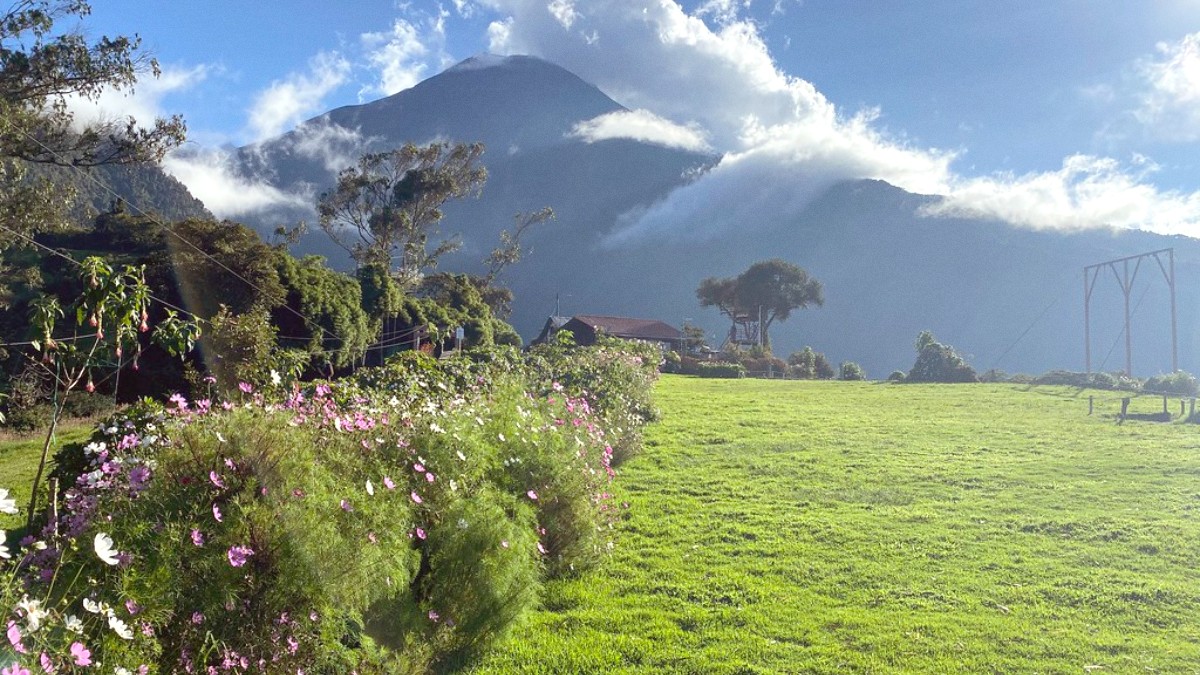
Central Highlands, Ecuador
The local cuisine in Baños reflects its unique environment. Highland staples like potatoes and corn are abundant, but the town's proximity to the Amazon introduces tropical fruits and river fish not always common in higher Andean cities. Historically, food was tied to agricultural cycles and local availability.
The blend of hearty, comforting highland dishes with lighter, fruitier Amazonian elements provides a distinct taste experience.
The foundation of many Ecuadorian dishes includes potatoes, various types of corn, plantains, rice, beans, and yuca. These provide the bulk and energy for local diets.
Pork, beef, and chicken are commonly consumed. Cuy (guinea pig) is a traditional Andean delicacy. Baños benefits from a wide variety of tropical fruits and fresh vegetables.
Ecuadorian cuisine is generally savory and comforting. While not overtly spicy, a chili sauce called 'ají' is almost always served on the side, customizing spice levels. Flavors can also be slightly sweet or tangy from various fruits in drinks and sauces.
A whole roasted pig, slow-cooked until the skin is crispy and the meat is tender. Often served with llapingachos (fried potato patties), mote (hominy), and curtido (pickled onion/tomato salad).
Find it at local markets (Mercado Central) or specialized "hornado" restaurants.
Chunks of fried pork, often boiled first for tenderness, then fried until golden. Served similarly to hornado, with mote, potatoes, and sometimes fried ripe plantain (maduro frito).
A hearty, savory dish.
Whole roasted guinea pig, a traditional Andean delicacy often served for celebrations. The meat is lean and has a distinct flavor. It typically comes with potatoes and a small salad.
You will find it at specific restaurants that traditional dishes.
A vegetarian take on ceviche, made with fresh mushrooms or chochos (Andean lupini beans), marinated in lime juice with onions, tomatoes, and cilantro. It a refreshing and lighter option.
A popular and simple snack consisting of French fries served with sliced hot dogs. It a common quick bite for all ages.
True "fine dining" is limited, but several establishments an elevated dining experience with excellent service and high-quality food.
You will find an abundance of mid-range restaurants in Baños's town center, serving a mix of Ecuadorian specialties and popular international dishes like pizza, pasta, and Tex-Mex.
For authentic and inexpensive meals, explore these options:
Vegetarian options are increasingly available, especially at mid-range restaurants and those catering to international tourists. Finding strictly vegan options is possible with careful communication. Focus on naturally plant-based staples.
Casa Hood receives good reviews for vegetarian and vegan-friendly menu items.
Many traditional Ecuadorian dishes are naturally gluten-free. Cross-contamination is a risk. Clearly communicate your allergy using a translation card.
For severe allergies, carry a detailed translation card explaining restrictions in Spanish.
Opportunities to visit small-scale sugarcane processing facilities. Some nature tours include stops at local fruit farms.
Local festivals often feature special traditional foods. Weekly "feria" (market day) is a good time to experience local food culture.
Watching artisans hand-pull sticky sugarcane taffy is an unique visual and culinary experience. Buy it fresh.
In the evenings, street vendors sell canelazo, a hot, spiced alcoholic drink. A warm, social experience.
Carry pre-translated cards explaining your dietary restrictions clearly and concisely in Spanish.
This bridges language barriers and helps staff.
Clearly communicate your needs to restaurant staff, especially for severe allergies, to avoid issues.
Be aware that comprehensive allergen knowledge may not be universal.
From budget-friendly local comedores to mid-range international restaurants, Baños offers a diverse dining scene.
During Holy Week (Semana Santa), look for Fanesca, a rich, traditional soup. Inquire locally for other seasonal specialties.
Several bars and restaurants in the town center feature live music, especially on weekends. Casa Hood known for regular live bands.
Several "discotecas" (nightclubs) and bars concentrated in the town center, playing a mix of Latin pop, reggaeton, salsa, cumbia, and international hits.
The main street, Ambato, and the surrounding blocks in the city center form the informal "bar district." You can easily walk between various bars, each with a different ambiance.
Mercado Central: a bustling hub for fresh produce, meats, and prepared food stalls. A place to observe local life. Artesanías Shops: Numerous shops line the streets, especially near the Basilica, selling souvenirs and handicrafts.
Visit in the morning for the freshest selection.
Tagua Nut Carvings: Ecuador renowned for intricate carvings from tagua nuts (vegetable ivory). Find jewelry, figurines. Leather Goods: Some shops offer locally made leather items. Woolen Goods: Colorful ponchos, scarves from nearby Andean highlands.
These are sustainable and unique local crafts.
Freshly made sugarcane taffy is the signature sweet souvenir from Baños. Buy it fresh from one of the many shops.
These are unique, sustainable, and lightweight souvenirs, perfect for gifts or personal keepsakes.
Locally grown and roasted coffee for an excellent gift or personal treat, capturing the essence of the region.
Support local artisans by buying directly from them. Avoid items made from endangered species, which are illegal to trade. Bargaining is generally not expected in established shops but might be acceptable with street vendors.